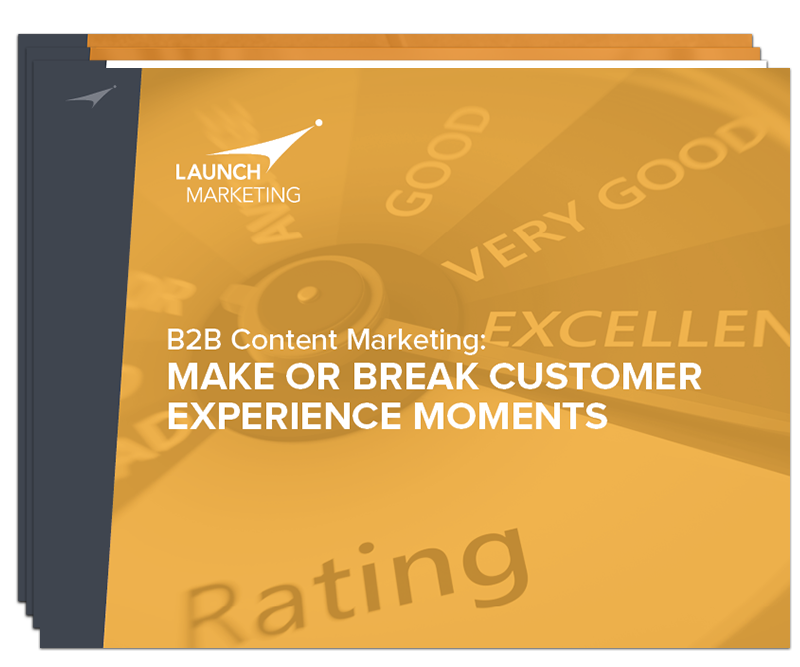
Measuring the progress and success of marketing initiatives requires tracking and analyzing the right metrics. For content marketing, these are meaningful datapoints that should be informed by the goals of your content. Here, we break down the primary metrics used to track the most common types of content marketing that B2B marketers use; website content (blogs, articles, eBooks), social media content and email content.
Ensure your content marketing creates exceptional interactions, moments and experiences with customers in their journey and download the B2B Content Marketing eBook.
Email Content Metrics
Email is among the most used content marketing tactic in B2B organizations. These are some of the main email content metrics you want to track to determine if you are meeting your email content marketing goals. While these are not the only metrics to track, they provide a solid high-level view of success and progress over time.
- Subscriber Growth: Although subscriber growth might not seem important to track, it’s a telltale sign to many things. If you are seeing a steady increase in subscribers it means that you are converting on the newsletter sign up forms you have on your website and also shows that the content you are creating is engaging enough for visitors to want to read more and stay subscribed.
- Unsubscribes: Knowing who is unsubscribing and when can be insightful to your content marketing. For example, if you had a handful of unsubscribes after a specific newsletter, examine why this might have happened. Was the content not relevant enough? Did you not have enough personalized elements? Did the subject line fail to engage them? These are all questions you can answer. Tracking this trend over time will be useful for future email content.
- Open Rate: Email opens are primarily influenced by subject lines. Use these best practices if you find yourself having difficulty creating subject lines. You want to have a high open rate. More importantly, you want to see your open rate related to previous sends increase. Having these metrics to look at over time can provide insight. A/B testing of different subject lines can also inform subject lines that are likely to perform better.
- Click-Through Rate: A high click-through rate (CTR) means that your content within your email was deemed click-worthy by those who engaged with it. When analyzing this, see what clicks performed best and why. Was it the call-to-action (CTA) they clicked? Was it the link embedded in a graphic? Answers to these questions can lead you to improving your content for your next email.
Website Content Metrics
Blogs and articles are among the most popular types of awareness-generating content that B2B marketers produce. These metrics are most useful for informing the success of those content types:
- Pageviews: Tracking the number of pageviews across respective posts shows which are performing the best. If you find that your article written on communication best practices is receiving the most pageviews out of all your articles, this is an opportunity to use a pop-up for a download or a place to add an extra CTA. Because there is a high volume of visitors, you want to use it to drive traffic to other valuable content pieces the user could be interested in.
- Form Conversions: The number of form conversions reveals what gated content is performing best. What CTAs linked to gated content are receiving the most form completions? How many newsletter signups are you receiving from sidebars on blogs or articles? Augmenting content that receives a large amount of views with links to gated content can increase the chance of a conversion.
- Acquisition: How you acquire your blog and article visitors is also a crucial metric to track. Are your users coming in primarily from a desktop or mobile? Are they coming to your website via organic search, social links, or a referral? These types of questions can be answered with the correct acquisition metrics. Increasing both the quality and quantity of content boosts your website traffic to your various content. You’ll find these metrics in tools like Google Analytics.
Social Media Metrics
B2B organizations should be on social media. For utilizing social media effectively, these are the key metrics to track across all your social media platforms to gauge social media content success:
- Impressions: It’s important for your content to be seen by others. Share original content and relevant third-party content to your followers. A high number of impressions means your content is being seen more by a variety of users. Tracking this over time will be insightful for the reach you are achieving.
- Engagement: Engagement is even more important than impressions. This shows that users are clicking and viewing your shared content. Tracking this across time can display what social content is performing well and what isn’t and can lead to adjustments in future posts.
- Followers: The more followers you have, the higher your impressions are. This also makes it more likely that your content will be seen and shared. If you are seeing an increase in followers, that means you have increased your brand awareness and are attracting more users to your content. Over time, track the changes in follower growth. Note when your followers are fluctuating and determine how that might relate to your content or other social strategy elements.
Tracking these specific metrics for website, social media and email content can benchmark the progress and goals for each. This is not an exhaustive list of the metrics to track but can be a good starting point for your organization.
If you need assistance with your content marketing metrics or analytics tracking, contact us today or request a free marketing consultation.

There are 3 comments